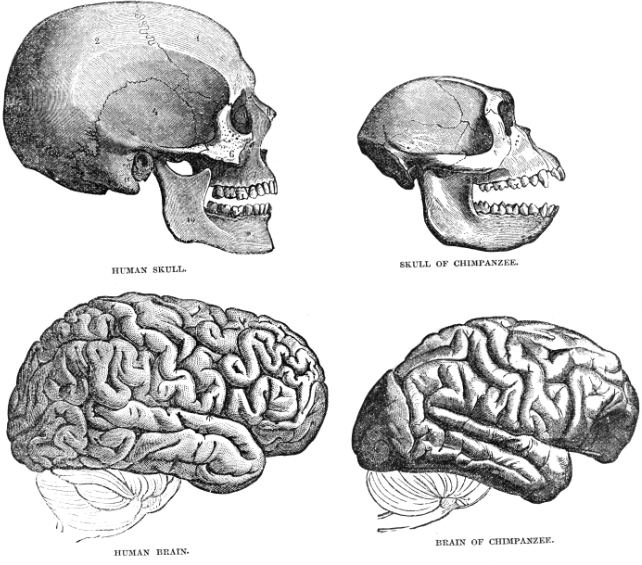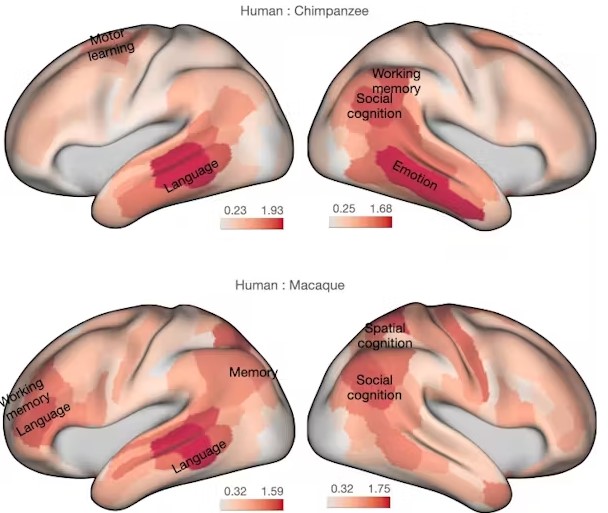New Study Identifies Unexpected Part of Your Brain That's Uniquely Human

For a long time, researchers have compared the human brain to those of other primates in an effort to better comprehend it. What makes our brains different from those of our closest ancestors is still a mystery to researchers.
By using a novel method—comparing the internal connections of brains—our most recent study might have advanced our cause.
Richard Owen, a Victorian palaeontologist, made the mistake of claiming that the human brain was unique in having a tiny region known as the Hippocampus minor. He asserted that this made it distinct from other animals and that, as a result, the human brain was obviously unconnected to those of other species.
By using a novel method—comparing the internal connections of brains—our most recent study might have advanced our cause.
Richard Owen, a Victorian palaeontologist, made the mistake of claiming that the human brain was unique in having a tiny region known as the Hippocampus minor. He asserted that this made it distinct from other animals and that, as a result, the human brain was obviously unconnected to those of other species.
Did you know? You can comment on this post! Just scroll down

Although we still have a lot to learn about the structure and operation of our brain, we have come a long way since then.
The majority of research that compares the human brain to those of other animals focuses on size. This could be the brain's overall size, the brain's size in relation to the body, or the size of individual brain regions in relation to the rest of the brain.
However, size measurements don't reveal anything about how the brain is organized within. An elephant's massive brain, for example, has three times as many neurons as a human brain, but most of them are found in the cerebellum rather than the neocortex, which is typically linked to human cognitive capacities.
The majority of research that compares the human brain to those of other animals focuses on size. This could be the brain's overall size, the brain's size in relation to the body, or the size of individual brain regions in relation to the rest of the brain.
However, size measurements don't reveal anything about how the brain is organized within. An elephant's massive brain, for example, has three times as many neurons as a human brain, but most of them are found in the cerebellum rather than the neocortex, which is typically linked to human cognitive capacities.
The study of the internal organization of the brain was laborious until recently. However, the development of medical imaging methods has created new opportunities to swiftly, thoroughly, and painlessly examine an animal's brain.
We made use of publicly accessible white matter MRI data, which shows the connections between various areas of the brain's cortex. Along these fibers, brain cells communicate with one another. The mammalian brain is very sparsely connected as a result of this energy-intensive process, focusing communications along a few number of core channels.
We can learn a lot about the functioning of each brain region from its connections. Each area of the brain has a distinct connectivity fingerprint because each region's arrangement of connections is so specialized.
We made use of publicly accessible white matter MRI data, which shows the connections between various areas of the brain's cortex. Along these fibers, brain cells communicate with one another. The mammalian brain is very sparsely connected as a result of this energy-intensive process, focusing communications along a few number of core channels.
We can learn a lot about the functioning of each brain region from its connections. Each area of the brain has a distinct connectivity fingerprint because each region's arrangement of connections is so specialized.
We examined these connection signatures in the brains of macaques, chimpanzees, and humans.
Chimpanzees and bonobos are the closest surviving relatives of humans. The non-human primate that science knows the most about is the macaque monkey. We were able to determine which aspects of the human brain are specific to us and which are probably shared by our non-human cousins by comparing the brains of the two species.
The prefrontal cortex, a collection of regions in the front of the brain associated with sophisticated thought and decision-making, has been the subject of a large portion of earlier study on the peculiarities of the human brain. We indeed found that aspects of prefrontal cortex had a connectivity fingerprint in the human that we couldn't find in the other animals, particularly when we compared the human to the macaque monkey.
Chimpanzees and bonobos are the closest surviving relatives of humans. The non-human primate that science knows the most about is the macaque monkey. We were able to determine which aspects of the human brain are specific to us and which are probably shared by our non-human cousins by comparing the brains of the two species.
The prefrontal cortex, a collection of regions in the front of the brain associated with sophisticated thought and decision-making, has been the subject of a large portion of earlier study on the peculiarities of the human brain. We indeed found that aspects of prefrontal cortex had a connectivity fingerprint in the human that we couldn't find in the other animals, particularly when we compared the human to the macaque monkey.

However, the prefrontal cortex was not where we identified the majority of the changes. The temporal lobe, a sizable portion of the brain situated roughly behind the ear, was where they were.
This region of the monkey brain is dedicated to the in-depth processing of data from our two primary senses, hearing and vision. The central region of the temporal cortex showed one of the most striking results.
The arcuate fasciculus, a white matter tract that connects the frontal and temporal cortex and has historically been linked to human language processing, was the characteristic that caused this difference. An arcuate fasciculus is present in the majority of primates, if not all of them, although it is significantly larger in human brains.
This region of the monkey brain is dedicated to the in-depth processing of data from our two primary senses, hearing and vision. The central region of the temporal cortex showed one of the most striking results.
The arcuate fasciculus, a white matter tract that connects the frontal and temporal cortex and has historically been linked to human language processing, was the characteristic that caused this difference. An arcuate fasciculus is present in the majority of primates, if not all of them, although it is significantly larger in human brains.
But we discovered that concentrating only on language can be too limited. Other cognitive processes, such interpreting complicated social behavior and integrating sensory information, are also carried out by the brain regions connected by the arcuate fasciculus.
We were the first to discover that the arcuate fasciculus has a role in these processes. This realization highlights the intricacy of the evolution of the human brain, indicating that several, interconnected changes in brain connectivity, rather than a single shift as previously believed by scientists, are responsible for our highly developed cognitive capacities.
Even while the middle temporal arcuate fasciculus plays a significant role in language processing, we also discovered species-specific variations in a location further back in the temporal cortex.
We were the first to discover that the arcuate fasciculus has a role in these processes. This realization highlights the intricacy of the evolution of the human brain, indicating that several, interconnected changes in brain connectivity, rather than a single shift as previously believed by scientists, are responsible for our highly developed cognitive capacities.
Even while the middle temporal arcuate fasciculus plays a significant role in language processing, we also discovered species-specific variations in a location further back in the temporal cortex.
A fundamental component of human social interaction, this temporoparietal junction region plays a crucial role in processing information about others, including comprehending their intents and beliefs.
This region of the brain in humans has far more extensive connections to other areas of the brain that interpret sophisticated visual information, including behavioral cues and facial emotions. This implies that, in contrast to our ape cousins, our brains are designed to manage more complex social processing. We are sociable beings by nature.
These results cast doubt on the notion that human intellect emerged as a result of a single evolutionary event. Rather, our research indicates that the evolution of the brain occurred gradually. According to our research, apes had alterations in the organization of their frontal cortex, which were followed by modifications in the temporal cortex in the human lineage.
This region of the brain in humans has far more extensive connections to other areas of the brain that interpret sophisticated visual information, including behavioral cues and facial emotions. This implies that, in contrast to our ape cousins, our brains are designed to manage more complex social processing. We are sociable beings by nature.
These results cast doubt on the notion that human intellect emerged as a result of a single evolutionary event. Rather, our research indicates that the evolution of the brain occurred gradually. According to our research, apes had alterations in the organization of their frontal cortex, which were followed by modifications in the temporal cortex in the human lineage.
One thing Richard Owen was correct about. To a certain degree, our brains differ from those of other animals. Because of the way our primate brains are wired, we are even more gregarious than other primates, which enables us to speak. The Discussion
Katherine Bryant, a postdoctoral fellow in neuroscience at Aix-Marseille Université (AMU), and Rogier Mars, a professor of neuroscience at the University of Oxford
Katherine Bryant, a postdoctoral fellow in neuroscience at Aix-Marseille Université (AMU), and Rogier Mars, a professor of neuroscience at the University of Oxford
Article Posted 1 Month ago. You can post your own articles and it will be published for free.
No Registration is required! But we review before publishing! Click here to get started

















